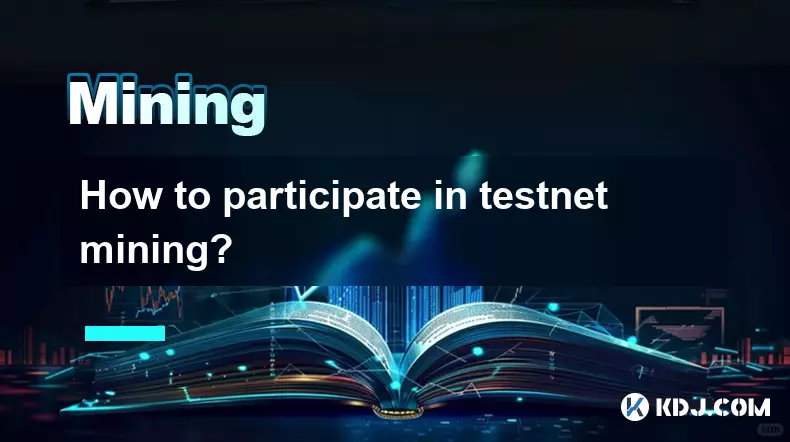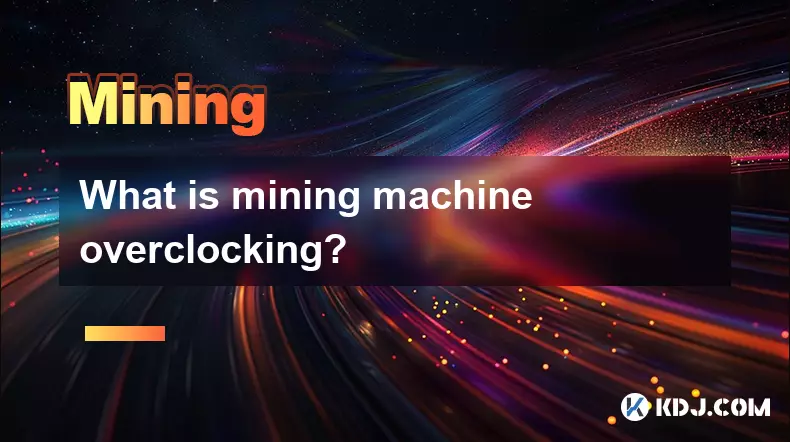-
 bitcoin
bitcoin $109667.069529 USD
-3.03% -
 ethereum
ethereum $3936.685804 USD
-4.07% -
 tether
tether $1.000493 USD
0.01% -
 xrp
xrp $2.771823 USD
-4.74% -
 bnb
bnb $957.805027 USD
-5.34% -
 solana
solana $196.735100 USD
-6.68% -
 usd-coin
usd-coin $0.999727 USD
-0.01% -
 dogecoin
dogecoin $0.227355 USD
-5.12% -
 tron
tron $0.335205 USD
-0.81% -
 cardano
cardano $0.779256 USD
-3.59% -
 ethena-usde
ethena-usde $0.999900 USD
-0.06% -
 hyperliquid
hyperliquid $42.492095 USD
-6.61% -
 chainlink
chainlink $20.501853 USD
-4.34% -
 avalanche
avalanche $28.952606 USD
-11.21% -
 stellar
stellar $0.356038 USD
-3.93%
How to participate in testnet mining?
Testnet mining lets developers and users safely test blockchain features using worthless tokens, helping identify bugs and prepare for mainnet launches.
Sep 22, 2025 at 09:18 am

Understanding Testnet Mining in the Crypto Ecosystem
1. Testnet mining is a method used by blockchain developers to simulate real-world conditions on a secondary network that mirrors the main blockchain. This environment allows developers and users to experiment without risking actual funds. Unlike mainnet operations, testnets use tokens that hold no monetary value, enabling safe testing of new features, consensus mechanisms, or smart contracts.
2. Participation in testnet mining helps identify bugs, stress-test network performance, and evaluate scalability under various loads. It also serves as a training ground for miners, node operators, and developers who want to familiarize themselves with upcoming protocol changes before they go live.
3. Many Layer 1 blockchains such as Ethereum, Solana, and Polkadot maintain active testnets like Goerli, Devnet, or Rococo. These networks often rely on community-driven participation to validate their robustness. Miners contribute computing power or stake test tokens to support consensus algorithms, whether Proof of Work, Proof of Stake, or others.
4. Some projects incentivize testnet participation by rewarding contributors with points, badges, or eligibility for future airdrops on the mainnet. While the mined tokens themselves are worthless, consistent involvement can establish reputation within developer communities and grant early access to ecosystem perks.
5. Before joining any testnet, it’s essential to verify its authenticity through official project channels. Scammers often create fake testnets to harvest wallet addresses or distribute malicious software. Always download client software from verified repositories and avoid sharing private keys under any circumstance.
Steps to Join a Testnet Mining Initiative
1. Begin by identifying a blockchain project actively running a testnet phase. Check the project’s official website, GitHub repository, or Discord server for announcements regarding testnet launches or mining programs. Projects typically publish detailed documentation outlining requirements and setup procedures.
2. Set up the necessary software environment. This may include installing a specific wallet, configuring a node using command-line tools, or downloading a mining client tailored for the testnet. Ensure your system meets hardware and OS compatibility standards outlined in the technical guide.
3. Obtain testnet tokens from a faucet—a service that distributes free tokens for trial purposes. These faucets usually require you to submit your public wallet address and may impose rate limits to prevent abuse. Without sufficient test tokens, you cannot cover gas fees or participate in staking-based testnets.
4. Configure your node or mining rig according to the network specifications. This could involve syncing with the testnet blockchain, adjusting configuration files, opening firewall ports, or connecting to seed nodes. Misconfigurations are common causes of failed participation.
5. Start mining or validating based on the consensus model. Monitor logs regularly to confirm your node is recognized by peers and contributing effectively. Report issues to development teams via proper channels if anomalies occur during operation.
Risks and Considerations in Testnet Activities
1. Running a testnet node consumes bandwidth, storage, and processing resources. Extended usage can impact device performance, especially on consumer-grade hardware. Allocate dedicated machines when possible to avoid interference with daily computing tasks.
2. Even though testnets don't involve real money, security practices must remain strict. Reusing mainnet wallet addresses or exposing seed phrases—even in testing—can lead to irreversible breaches once those keys are associated with valuable assets.
3. Some testnets implement aggressive incentive structures that encourage spam transactions or resource exhaustion. Engaging in such behavior might result in being blacklisted from future participation or damage your standing in the community.
4. Not all testnets are long-lived. Networks may be deprecated after achieving their goals, rendering any accumulated points or reputational gains obsolete. Stay updated on project timelines to avoid investing effort into inactive chains.
5. Open-source contributions tied to testnet activity, such as bug reports or code improvements, carry more lasting value than mere token accumulation. Active engagement enhances credibility and opens doors to collaboration opportunities within the crypto space.
Frequently Asked Questions
What is a blockchain testnet?A blockchain testnet is an isolated replica of a mainnet used for experimentation. It enables developers and users to test applications, upgrades, and network behaviors without affecting the primary chain or using real cryptocurrency.
Can I earn real money from testnet mining?Direct earnings from testnet tokens are impossible since they have no market value. However, some projects reward active participants with future airdrop allocations or whitelist spots for NFT mints, indirectly creating potential financial benefit.
How do I find legitimate testnet faucets?Legitimate faucets are hosted on official project domains or linked from verified social media accounts and documentation pages. Avoid third-party sites claiming to offer rare test tokens; these often distribute malware or phishing links.
Is running a testnet node the same as mainnet staking?No. Testnet nodes simulate staking or mining functions but do not secure real economic value. The process helps understand mechanics and troubleshoot setups but lacks the financial risks and rewards inherent in mainnet operations.
Disclaimer:info@kdj.com
The information provided is not trading advice. kdj.com does not assume any responsibility for any investments made based on the information provided in this article. Cryptocurrencies are highly volatile and it is highly recommended that you invest with caution after thorough research!
If you believe that the content used on this website infringes your copyright, please contact us immediately (info@kdj.com) and we will delete it promptly.
- Bitwise, Hyperliquid ETF, and Perp DEXs: A New Era in Crypto Trading?
- 2025-09-26 12:25:15
- Ozak AI Price Prediction: Analyst Bull Case for $5 by 2026?
- 2025-09-26 12:25:15
- Bitcoin Price Wobbles: Support Failure and Trader Sentiment in the Mix
- 2025-09-26 12:45:16
- Dogecoin, Memecoins, and the Bull Cycle: Are We Still Barking Up the Right Tree?
- 2025-09-26 12:45:16
- Plasma Ignites DeFi: A New Dawn for Stablecoins and TVL?
- 2025-09-26 12:50:01
- Crypto Tax, Senate Showdown, and Trump Relief: What's the Deal?
- 2025-09-26 12:30:01
Related knowledge

The difference between staking and mining
Sep 24,2025 at 05:18am
Understanding Staking in the Cryptocurrency Ecosystem1. Staking involves holding funds in a cryptocurrency wallet to support the operations of a block...

How to participate in testnet mining?
Sep 22,2025 at 09:18am
Understanding Testnet Mining in the Crypto Ecosystem1. Testnet mining is a method used by blockchain developers to simulate real-world conditions on a...

How to dispose of abandoned mining machines?
Sep 19,2025 at 08:19pm
Assessing the Condition of Abandoned Mining Rigs1. Begin by inspecting each mining machine for visible damage, corrosion, or missing components. Machi...

How to identify high-quality mining pools?
Sep 21,2025 at 03:19pm
Reputation and Track Record1. A mining pool’s reputation is built over time through consistent performance and transparency. Pools that have operated ...

Advantages of decentralized mining pools
Sep 20,2025 at 04:36pm
Enhanced Security and Resistance to Censorship1. Decentralized mining pools operate on blockchain-based smart contracts, eliminating the need for a ce...

What is mining machine overclocking?
Sep 21,2025 at 07:19pm
Understanding Mining Machine Overclocking1. Mining machine overclocking refers to the process of increasing the operating frequency of a cryptocurrenc...

The difference between staking and mining
Sep 24,2025 at 05:18am
Understanding Staking in the Cryptocurrency Ecosystem1. Staking involves holding funds in a cryptocurrency wallet to support the operations of a block...

How to participate in testnet mining?
Sep 22,2025 at 09:18am
Understanding Testnet Mining in the Crypto Ecosystem1. Testnet mining is a method used by blockchain developers to simulate real-world conditions on a...

How to dispose of abandoned mining machines?
Sep 19,2025 at 08:19pm
Assessing the Condition of Abandoned Mining Rigs1. Begin by inspecting each mining machine for visible damage, corrosion, or missing components. Machi...

How to identify high-quality mining pools?
Sep 21,2025 at 03:19pm
Reputation and Track Record1. A mining pool’s reputation is built over time through consistent performance and transparency. Pools that have operated ...

Advantages of decentralized mining pools
Sep 20,2025 at 04:36pm
Enhanced Security and Resistance to Censorship1. Decentralized mining pools operate on blockchain-based smart contracts, eliminating the need for a ce...

What is mining machine overclocking?
Sep 21,2025 at 07:19pm
Understanding Mining Machine Overclocking1. Mining machine overclocking refers to the process of increasing the operating frequency of a cryptocurrenc...
See all articles










































































